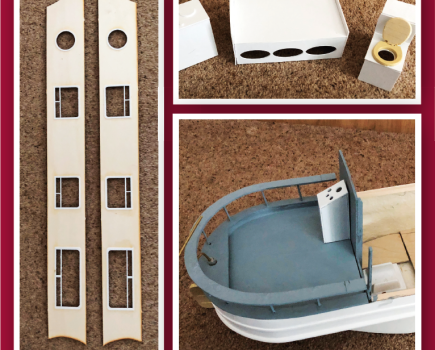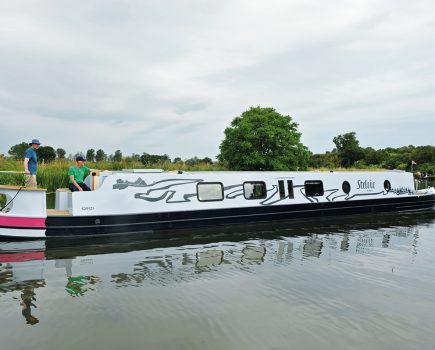Many waterways take decades to restore, but here’s one which could be completed much more quickly. We look at a new scheme to revive north Kent’s Dartford & Crayford Navigation

You’ll be used to reading in these articles about canal restoration projects whose lifetime is measured in decades, whose cost runs into tens of millions, where abandoned waterways have been obstructed by infilling, by new roads, buildings and even railway lines. And this often applies even more so to the more recently launched projects, where there has been more opportunity for modern construction to destroy much of the historic fabric before restoration was even proposed – but where despite everything, dedicated teams of enthusiasts have plans to overcome all these difficulties, albeit the expression “not in my lifetime” may occasionally be heard from some of the older supporters…
So it comes as rather a change to encounter a relatively recently launched new waterway restoration scheme where there are no such blockages, the sum total of the engineering work needed for completion is the restoration of a single lock and the removal of one unused bridge, and almost all of the waterway is already sort-of navigable after a fashion. At least sufficiently navigable that if you’d visited it in late May, you’d have found a sailing barge and a flotilla of narrowboats moored on it.
Sure, it’s only a short waterway at less than three miles long, so it’s not quite in the same league as the Cotswold, the Chesterfield, the Montgomery and all the other long-term restorations. But it could still be a really good example of a ‘quick win’ which would show how in some cases waterway restoration can provide good results at a modest cost and to a short timescale.

This waterway in question is the River Darent – sometimes referred to as the Dartford Creek, and historically as the Dartford & Crayford Navigation. It consists of just under three miles of the tidal creek which forms the lower reaches of the Darent from Dartford to where it meets the Thames a couple of miles upstream of the QE2 Bridge. Just upstream of its midpoint, it’s joined by the River Cray whose tidal reaches form a branch leading to Crayford.
Until the early 19th century it wasn’t much different from a number of other tidal creeks joining the Thames estuary. And despite it being used regularly by sailing barges and other cargo craft, it might have seemed fanciful to talk of this unimproved muddy creek as a navigation. But following an unsuccessful plan in 1835 to replace it with a short ship canal which would have been capable of taking 300-400 ton vessels to Dartford, a more modest project saw it shortened and straightened in several places to improve navigation. And if that didn’t qualify it as a navigation, surely the construction of a lock and adjacent set of sluices in 1895, turning the top half mile into an impounded length with water in it at all times, surely justified regarding it as an inland waterway.
Unfortunately by the mid-1980s the last cargo-carrying craft had long since left the waterway, and the then navigation authority proposed to chain back the lock gates, turn it back into an entirely tidal creek, and effectively abandon the navigation. Even at the time I remember thinking (as someone who’d already been involved in canal restoration for several years) that it seemed odd and a very backward step for a navigable waterway to be proposed for abandonment. However despite protestations from the London branch of the Inland Waterways Association that it would mean the loss of a public amenity and a potentially useful non-tidal refuge off the estuary, the authority saw no likelihood of it being used as such, and went ahead with the chaining-back of the gates.

But as mentioned earlier, that didn’t stop if from still being ‘sort-of navigable after a fashion’: for intrepid boaters prepared to head up the creek and through the derelict lock chamber on a rising tide, avoid being trapped under the non-functioning swingbridge above, and get out again before the ebb tide meant the creek dried out again, it provided an opportunity to cross off another waterway on your map. We previously reported on the Tuesday Night Club visiting it as part of their mission to navigate the entire network. And St Pancras Cruising Club have paid occasional visits on their various Thames tideway forays.
But this year’s SPCC ‘Five Creeks’ cruise, the latest to visit Dartford, was different. Because in recent years, a local group has been formed with the aim of putting the lock back into use and turning the creek back into a ‘proper’ navigation – so the cruise wasn’t just a bit of adventurous boating, it was part of a campaign event to support the restoration.
The story goes back to 2015, when a group of people met in the Hufflers pub (it takes its name from the men who used to make a living as casual labour helping sailing barge crews with the hard work of getting their craft up and down the creek). Their aim was agree on “what to do about this forgotten backwater”. The banks of the creek and the lock had become overgrown, the channel was full of rubbish, the place was a mess, and it had become thoroughly uninviting for any boaters who might want to visit.

They formed a Facebook group called ‘Friends of the Dartford and Crayford Creek’, set about recruiting volunteers and began organising clearance working parties. An assortment of bikes, shopping trolleys, tyres and the occasional wheely bin full of mud (“like trying to haul an uncooperative elephant out”) were hooked out of the creek, while litter-pickers cleared the banks. They also monitored the height and timing of the tides (there were no tide tables for the creek) to build up knowledge of when it was safe to navigate, and appointed a volunteer lengthsman to look after the waterway.
A first waterborne visitor, narrowboat Pentargon Springer, was followed by others. And in March 2016 the The Dartford and Crayford Creek Restoration Trust was formally incorporated, with aims including restoring the creeks for navigation, improving recreational facilities, and providing information on heritage and wildlife.
Two years on, the locksides whose coping stones had disappeared under the undergrowth are neat and tidy, a slipway near the head of navigation has been cleared, and work on clearing the creek has progressed from hauling out rubbish to digging out the silt. And in late 2017 an important visitor arrived: the Thames sailing barge Decima, which has been there since then, sitting on the mud above the lock at low tide or floating at high water. Not only has this made a good place for the owner to overwinter and work on her, but she has been an excellent generator of publicity for the Trust and its aims. She also led to the first step towards getting the lock working: clearance of silt around the gates (by hand, at low tide) to enable them to be opened far enough to get the barge through. This work continues in the area just below the lock, because the Decima will need to turn there before she returns to the estuary this summer.

In late May, everything came together for the first Dartford Nautical Festival. SPCC’s cruise saw a flotilla of narrowboats arrive and stay for a week, sitting on the bottom in and just above the lock chamber at low water. The festival, on the weekend that the narrowboats arrived, featured music, dancers, canoes and small craft – with the local residents and local authorities now very much ‘on board’ (quite literally, the Mayor was welcomed aboard the Decima during the event).
So what’s changed since the 1980s to make the Darent a potentially attractive destination for boaters, making it worth restoring the lock? Well, a look at what’s going on around the head of the navigation in Dartford gives an idea: what 30 years ago was a heavily industrial area is now a building site, with new housing under construction. Look at the developers’ publicity, and you’ll see artists’ impressions of the waterside housing – complete with narrowboats!
The Trust believes that it could make an attractive place to moor boats, a useful non-tidal refuge off the estuary, and perhaps home to a liveaboard community.

But what of the practicalities? Despite three decades of disuse, the timber lock gates are still in surprisingly good condition – certainly the framing appears solid, even if some planking needs replacing. And it will only be necessary to restore one set of gates (at least initially), as craft will generally be arriving and leaving when the tide is high enough to make a level. And it has even proved possible to get the unusual worm-driven paddle gear to move. But really, the first aim is to clear enough silt to get the gates to operate, and then it will become clearer how much work on the lock is actually needed.
If the gates do have to come out, it will cost – but with the local council favourable and housing developments going on above the lock, it’s not out of the question for money to come from ‘Section 106’ planning agreements where developers pay for local improvements as part of the terms of the approval.
At the same time as restoring it to operation, the former walkway across the lock gates and adjacent weir and sluices could be reinstated, giving access between the lock and the modern housing opposite.

Other than the lock (and a fair bit of dredging), what else is needed to make it a useful navigation? Obviously somewhere to moor – and with the section above the lock still subject to some variation in water level around high water, that means pontoons.
There’s also one former manually operated liftbridge some distance upstream of the lock, but the Trust believes this can be put back into working order. And just beyond, not far short of the terminus basin, is a fixed low level concrete bridge. But it no longer serves any useful purpose since the redevelopment of the area around the waterway, so it could be removed.
So far we haven’t mentioned the Crayford Creek, which branches off some distance below the lock. I ask the Trust if they have plans for this too. It’s a little different as it has no lock, so any boats visiting will need to be able to sit on the bottom at low water – but the ground conditions are more suited to this in Crayford. Anyway, the Trust’s view is ‘Let’s do Dartford first’ – but given how much they’ve achieved, and how achievable the Darent restoration is, that might not be too long.
Image(s) provided by:
Martin Ludgate








